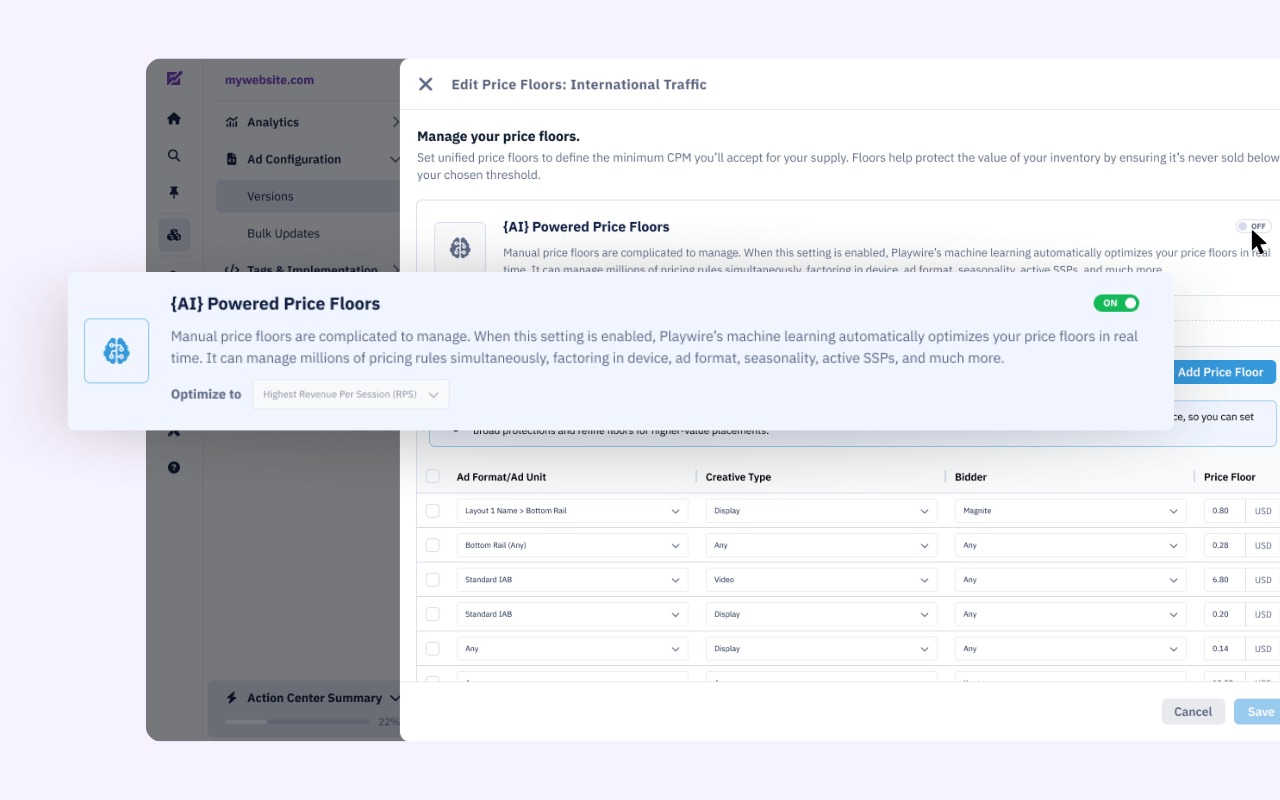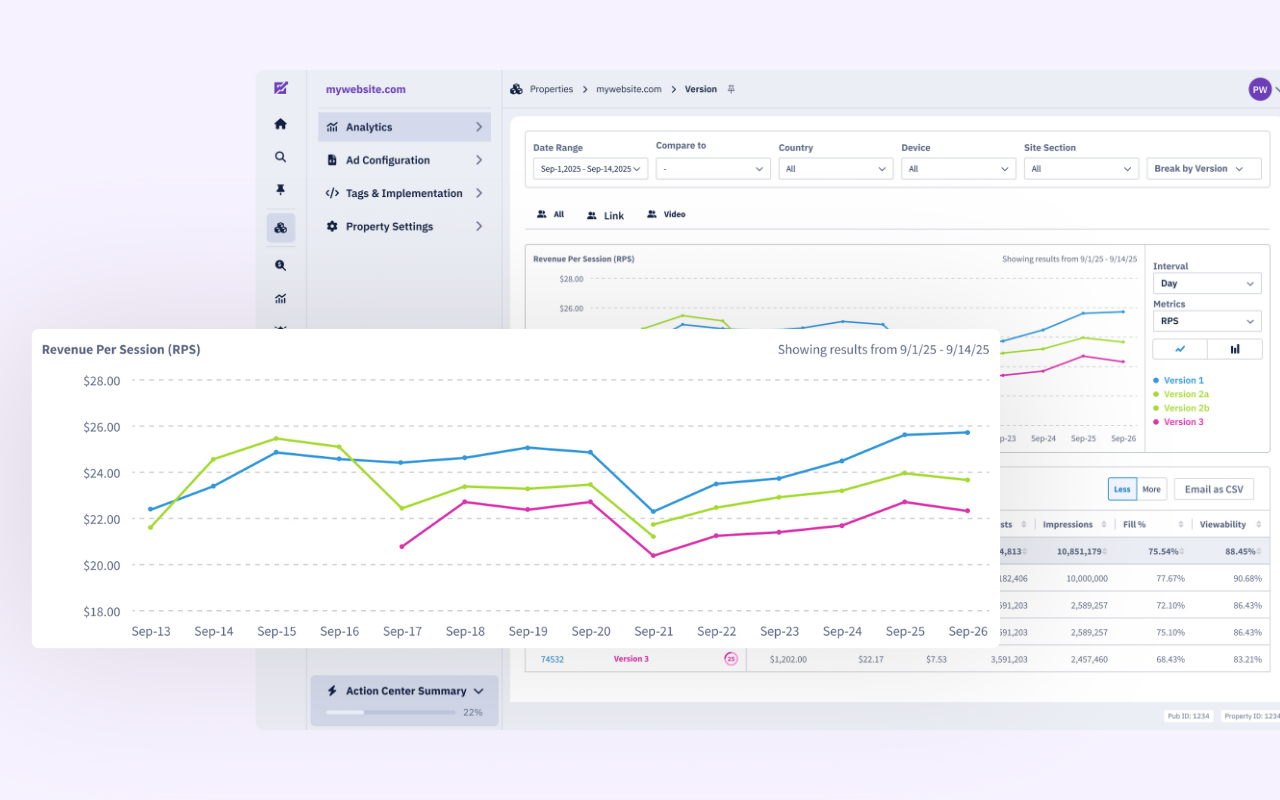Best Ad Networks for Website Monetization: Publisher's Guide to Maximum Revenue
October 28, 2025
Editorial Policy
All of our content is generated by subject matter experts with years of ad tech experience and structured by writers and educators for ease of use and digestibility. Learn more about our rigorous interview, content production and review process here.

Key Points
- Strategic network selection impacts revenue by 40-60%, with premium demand sources significantly outperforming basic ad networks through higher CPMs and better fill rates
- Self-service platforms eliminate management complexity by integrating multiple ad networks through a single implementation while providing complete transparency and control
- Modern monetization combines programmatic advertising, header bidding, and direct sales to maximize revenue from every impression through real-time competition
- Evaluation criteria extend beyond revenue share to include fill rate consistency, actual CPM performance, technical integration quality, and transparent reporting capabilities
- Publisher success requires ongoing optimization through A/B testing, price floor strategies, and demand source management rather than set-and-forget approaches
The Network Decision That Determines Your Revenue
Choosing the best ad networks for website monetization used to be straightforward. You picked a network, added their tags, and watched the pennies roll in. That approach leaves serious money on the table today because the ad tech landscape has evolved dramatically.
Publishers now navigate a complex ecosystem where selecting the right monetization strategy can mean the difference between sustainable business growth and barely covering hosting costs. The revenue gaps between mediocre and excellent network solutions have widened significantly as sophisticated technology and premium demand sources separate industry leaders from basic options.
Visit our full Ad Monetization Platform resource center.
What Separates Top Ad Networks from the Rest
The best ad networks for website monetization share specific characteristics that drive measurable revenue improvements. Understanding these fundamentals helps you evaluate options without getting lost in marketing promises that don't translate to actual results.
Quality networks maintain relationships with premium demand sources that actively bid on your inventory rather than just filling remnant space. They offer transparent reporting that shows exactly where revenue originates, enabling informed optimization decisions.
Technical integration quality matters more than most publishers realize initially. Networks supporting modern standards like header bidding, providing clean code implementation, and maintaining fast load times protect your SEO performance while maximizing ad revenue. Payment reliability and reasonable terms keep your business running smoothly without cash flow gaps that hurt operations.
Understanding Ad Network Categories
Different network types serve distinct purposes in a complete monetization strategy. Each brings specific strengths that work best for certain traffic profiles and business models.
Programmatic networks provide broad demand through automated auctions connecting publishers with multiple advertisers simultaneously. They excel for high-volume sites with diverse audiences, typically delivering CPMs between $2-8 depending on traffic quality and vertical.
Premium direct networks focus on higher CPMs through direct advertiser relationships but require specific audience profiles or content niches. Video networks specialize in video inventory with premium pricing but demand specific technical implementation. Native networks blend advertisements into content for improved user experience at moderate CPMs.
Mobile app networks serve in-app inventory with specialized formats and measurement capabilities tailored to app environments rather than web properties.
Modern Monetization Platforms vs Traditional Networks
The traditional approach had publishers managing individual network relationships separately. You integrated different tags, tracked performance across multiple dashboards, and attempted optimizing each network independently without unified visibility.
This fragmented methodology creates several problems that limit revenue potential. You can't see unified performance across all demand sources. You waste time managing multiple logins, payment schedules, and support relationships. Most critically, you lack technology enabling networks to compete in real-time for each impression.
Modern self-service platforms solve these issues by aggregating multiple ad networks into unified interfaces. Publishers gain comprehensive reporting, consolidated payments, and sophisticated optimization tools. The platform manages network relationships, technical integration, and performance monitoring while publishers maintain complete control over strategy and settings.
Evaluating Networks Like a Professional
Smart publishers look beyond headline revenue share percentages to understand true network performance. These evaluation criteria separate legitimate opportunities from time-wasting distractions.
- Actual CPM performance requires data from similar publishers in your vertical and traffic profile. General CPM ranges matter less than performance on sites like yours with comparable audiences. Request specific performance data rather than accepting vague promises.
- Payment terms and reliability impact cash flow directly. Understand minimum payout thresholds, payment schedules, and any deductions or fees. Net 60 payment terms with high minimums create problems for smaller publishers managing operating expenses.
- Technical requirements deserve careful review before commitment. Evaluate integration complexity, page load impact, and support for modern standards. Poor technical implementation hurts SEO and user experience regardless of revenue potential.
- Reporting transparency enables effective optimization. Demand granular reporting showing impression-level data, demand source breakdown, and real-time performance. Black box reporting hides problems until they've already cost significant revenue.
- Support quality determines problem resolution speed. Test support responsiveness and technical expertise before committing resources. You need partners who troubleshoot integration issues and optimize performance actively rather than sending boilerplate responses.
Self-Service Platform Advantages
Self-service monetization platforms represent ad network management evolution. They provide infrastructure running multiple networks simultaneously while maintaining complete control and visibility into operations.
These platforms handle technical complexity integrating numerous demand sources through single implementations. Publishers configure their own strategies, run their own tests, and make their own optimization decisions without waiting for account manager availability. The platform manages header bidding auctions, price floor optimization, and demand source performance automatically based on publisher-defined rules.
RAMP Self-Service exemplifies this approach by combining multiple demand sources with AI-powered optimization and complete transparency. Publishers see every setting, control every strategy element, and access identical tools whether managing single sites or entire networks.

Technical Integration Essentials
Integration complexity varies dramatically across network options. Understanding technical requirements helps you avoid implementation headaches and performance issues that damage both revenue and user experience.
Header bidding implementation requires careful attention to timeout settings, bidder selection, and auction configuration. Poor setup creates latency issues hurting user experience and SEO rankings. Self-service platforms handle this complexity while providing control over strategy elements that actually matter for revenue.
- Page speed impact affects both revenue and rankings. Every network adds code affecting load times. Modern implementation through single-tag solutions minimizes this impact while accessing multiple demand sources. Measure Core Web Vitals before and after network additions ensuring you're not sacrificing SEO performance for ad revenue.
- Mobile optimization deserves specific attention since mobile traffic dominates most publisher audiences. Test network performance specifically on mobile devices ensuring ads render properly across screen sizes and connection speeds.
- Video implementation delivers higher CPMs but requires specialized technical setup. Confirm networks support your video player, handle VAST/VPAID standards correctly, and maintain viewability standards for video inventory.
Revenue Optimization Strategies
Maximizing network performance requires ongoing optimization rather than set-and-forget approaches. These strategies help publishers continuously improve results without constant manual intervention.
A/B testing identifies which networks, placements, and configurations deliver optimal results for your specific traffic. Run controlled experiments isolating individual variables. Track impact on both revenue metrics and user engagement ensuring optimization doesn't hurt long-term business performance.
Price floor strategies control which networks win auctions at different price points. Dynamic floors based on device, geography, and time maximize revenue by setting appropriate minimums for each impression. This requires sophisticated tools that most individual networks don't provide but modern platforms handle automatically.
Demand source management requires weekly monitoring of individual network performance to identify underperformers. Networks consistently delivering low fill rates or bottom-tier CPMs waste impressions that could go to better demand sources. Replace poor performers quickly rather than hoping they improve over time.
Seasonal optimization adapts to ad demand fluctuations throughout the year with major spikes during Q4 and dips during summer months. Adjust strategies seasonally to capitalize on high-demand periods while maintaining baseline performance during slower times.
Modern Monetization Approach
Smart publishers have moved beyond choosing single ad networks. They're building complete monetization stacks combining multiple demand sources with intelligent optimization technology.
This approach uses self-service platforms aggregating premium networks, programmatic demand, header bidding, and direct sales into unified operations. AI and machine learning handle complex optimization that humans can't manage at scale. Publishers maintain complete control over strategy while letting technology manage tactical execution driving better results.
The infrastructure supports experimentation without risk. Publishers test new networks, formats, and strategies on traffic subsets before full deployment. Real-time analytics show exactly which changes improve performance and which don't work for specific audience segments.

Why RAMP Self-Service Changes Everything
Traditional ad networks force you to choose between control and convenience. Managed services offer simplicity but hide details you need understanding your business. Self-managed networks give control but create operational complexity draining resources from content creation and audience growth.
RAMP Self-Service solves this by providing publishers with complete transparency and control. You manage multiple premium demand sources through single interfaces. AI-powered optimization handles tactical decisions requiring analysis of millions of data points while you focus on strategic choices mattering for your business.
The platform combines programmatic networks, header bidding, direct sales, and video monetization in unified environments. You see every setting, control every strategy element, and access real-time analytics showing exactly how your monetization performs. No black boxes, no hidden fees, no mysterious drops taking days to investigate.
Publishers using RAMP maintain full ownership of their demand relationships while benefiting from Playwire's partnerships with premium networks. Rules-based control systems let you define exactly how you want ads to behave under any condition. When you want automation, machine learning handles optimization more effectively than manual management while remaining completely transparent about its decisions.
Making Your Network Selection
The best ad network for website monetization depends on your specific situation rather than universal rankings. Consider your traffic volume, audience profile, content type, and technical resources when evaluating options.
Small publishers building their first 100K monthly pageviews should start with simple options like Google AdSense requiring minimal technical expertise. Focus on growing traffic and creating quality content rather than complex monetization optimization. Once you reach consistent traffic levels, evaluate platform options providing access to better demand sources.
Medium publishers with 500K to 5M monthly pageviews benefit most from self-service platforms aggregating multiple networks. You have enough traffic justifying optimization effort but probably lack team size managing numerous individual relationships. Platform solutions maximize revenue while keeping operations manageable.
Large publishers and networks need enterprise-grade solutions with complete customization capabilities. RAMP Self-Service provides control required managing sophisticated strategies across multiple properties while maintaining automation making large-scale operations practical.
Start Building Better Revenue Today
Website monetization deserves more than generic ad networks treating your inventory like commodities. Your audience, your content, and your revenue deserve transparent partners with technology that actually delivers measurable results.
Quality content deserves quality monetization. Your audience deserves respect through non-intrusive ad experiences. Your revenue deserves transparency showing exactly where every dollar originates. See how RAMP Self-Service puts you in control of every element of your ad monetization strategy with the best ad networks for website monetization working together seamlessly.
Ready for ad tech that works for you? Start building better revenue with a platform designed by publishers, for publishers who refuse to settle for mediocre results.

-1.png?width=800&height=157&name=1-playwire-logo-primary-2021%20(1)-1.png)









